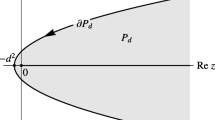Abstract
Upward continuation from a non-level surface may be performed by an integral equation method as shown previously by Bhattacharyya and Chan. Integration over the double layer is often computed using a centroid rule quadrature formula, but under certain circumstances more accurate formulae are required. One such formula may be found using a geometric approach. The result is equivalent to an expression recently published by Hansen and Miyazaki.
Similar content being viewed by others
References
Atkinson, K. E.,The Numerical Solution of Laplace's Equation in Three Dimensions — II, inNumerical Treatment of Integral Equations (eds. J. Albrecht and L. Collatz) (Birkhauser Verlag, Basel 1980).
Atkinson, K. E. (1982).The Numerical Solution of Laplace's Equation in three Dimensions, SIAM J. Numer. Anal.19, 263–274.
Barnett, C. T. (1976).Theoretical Modeling of the Magnetic and Gravitational Fields of an Arbitrarily Shaped Three-dimensional Body, Geophysics41, 1353–1364.
Bhattacharyya, B. K., andChan, K. C. (1977),Reduction of Magnetic and Gravity Data on an Arbitrary Surface Acquired in a Region of High Topographic Relief, Geophysics42, 1411–1430.
Garabedian, P. R.,Partial Differential Equations (John Wiley, New York 1964).
Hansen, R. O., andMiyazaki, Y. (1984),Continuation of Potential Fields Between Arbitrary Surfaces, Geophysics49, 787–795.
Henderson, R. G. (1970).On the Validity of the Use of the Upward Continuation Integral for Total Magnetic Intensity Data, Geophysics35, 916–919.
Jackson, J. D. Classical Electrodynamics, 2nd edn. (John Wiley, New York 1975).
Jaswon, M. A., andSymm, G. T.,Integral Equation Methods in Potential Theory and Elastostatics (Academic Press, New York 1977).
Kellogg, O. D.,Foundations of Potential Theory (Springer, Berlin 1929, reprinted by Dover Publications, New York 1953).
Martinez, G. andSancho, M. (1983),Integral Equation Methods in Electrostatics, Am. J. Phys.51, 170–173.
Phillips, D. L. (1962).A Technique for the Numerical Solution of Certain Integral Equations of the First Kind, J. Assoc. Comput. Mach.9, 84–97.
Salmon, G. (1927).A Treatise on the Analytic Geometry of Three Dimensions, Vol. I, 7 by Chelsea Publ. Co., New York 1958).
Author information
Authors and Affiliations
Rights and permissions
About this article
Cite this article
Ray, R.D. Continuation by integral equation methods: A note on surface integration over the double layer. PAGEOPH 122, 725–730 (1984). https://doi.org/10.1007/BF01101877
Received:
Accepted:
Issue Date:
DOI: https://doi.org/10.1007/BF01101877




